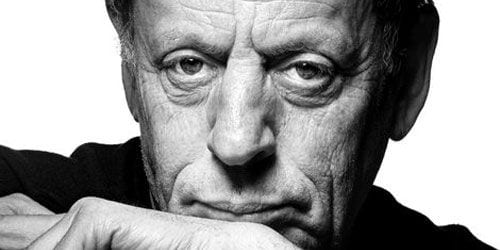
Director Scott Hicks is no stranger to portrayals of musical genius, having memorably told the story of David Helfgott in his acclaimed 1996 film Shine. The memory of that film is arguably dominated by the accurate but wild lead performance by Geoffrey Rush, and as a result viewers might overlook its more thoughtful, less histrionic elements. In Glass: A Portrait of Philip in Twelve Parts, Hicks finds a better fit between the life and work of the title character and his own intelligence and restraint as a filmmaker.
Composer Philip Glass is a surprisingly controversial creative figure, testing popular notions of classical music with his trademark repetitive compositions in the ‘60s and ‘70s. Having studied under both Nadia Boulanger and Ravi Shankar, Glass describes his approach as the product of Western and Eastern influences, “music so radical [he] could be mistaken for an idiot”.
Now a septuagenarian, Glass shows no signs of slowing down, and Hicks follows the composer through the better part of two years as he develops and debuts several different works, including four film scores, an opera and the world premiere of a new symphony. Throughout all of this, Glass remains refreshingly open to both the cameras and to the world around him.
Unlike so many artists who become subjects of documentaries, Glass seems uninterested in a self-portrait that mythologizes his career. Instead, he treats Hicks as a collaborator, accepting his presence in the journey, and never breaking his artistic, familial and spiritual practices for the sake of the camera. This sense of closeness and comfort is necessary to the success of a cinema verite piece, and Hicks capitalizes on the special relationship with his subject — a relationship that is almost certainly the product of a great deal of patience and generosity on the part of the director.
Separated into 12 parts, the documentary’s structure echoes the construction of a Glass composition as it addresses different temporal, emotional, and stylistic stages of the artist’s life. This conscious segmentation also helps to mask what might otherwise seem to be a lack of significant transitions. As the film skips from “A Day at the Office” to “Downtown” to “Summer in Nova Scotia” in its first three parts, Glass remains a compelling figure that anchors the sometimes too-elliptical organization.
“Downtown” provides a sweetly reminiscent visit with Chuck Close, but it unfortunately also brings to mind Tony Soprano’s assertion that “’remember when’ is the lowest form of conversation.’” Compared to the more alive, participatory material Hicks captures, conversations about the old days seem less essential to the film.
But the documentary quickly finds its way again in the rapport between Hicks and Glass and the various narrators that fill in the information Glass neglects to mention. Interviews with those outside of the art world are frequently the most revealing, with Glass’ brother and sister providing details about the path he took to music. To hear them tell the story is to realize that Philip Glass found his passion in a relatively healthy, natural way that upends the tales of obsession that mark far too many tales of musical genius.
This sense of balance and normalcy becomes a hallmark of the film. There are wonderfully frank interviews with wife Holly Glass, and the material shot in their apartment as well as their Nova Scotia vacation house pulls back the curtain on the mundane family life of the renowned artist. To see Philip Glass preparing pizza from scratch or playing with his young children is not interesting in and of itself. But Hicks skillfully uses such moments in order to both coax commentary from the subject as well as make observational connections to the film’s themes of collaboration and life as a work-in-progress.
Segment five — “Riding to Work on Mars” — concerns Glass’ contributions to the films of Errol Morris, Godfrey Reggio, Woody Allen, and Martin Scorsese. Interviews with these filmmakers provide substantial insight into the intersection of film and music. Part nine, “The Spirit Within”, reveals Glass’ multifaceted spiritual life. His repeated comparison of music to an underground river becomes a motif within the film. Glass goes where the music takes him, from the world premiere of Symphony No. 8 at the Brooklyn Academy of Music to the editing room for Allen’s Cassandra’s Dream to opening night of opera Waiting for the Barbarians at the Erfurt Theater in Germany. Throughout, his passion for the journey seems more meaningful to him than the result.
The emotional climax is a late interview with Holly, and it is one of the most unadulterated moments to be found in a modern documentary film. Hicks handles the truth of the material in a manner that is unflinching but tasteful, and crucially laced with ironic humor. This is a singular moment that conveys the complex “underlying passion” of the world of Philip Glass more powerfully than anything else in the film.
Extra features on the DVD are bountiful. These include valuable hours of extended interviews with Philip Glass, deleted and extended scenes, and performances of “Dracula”, “Metamorphosis”, “Orion” and “Einstein on the Beach”.
